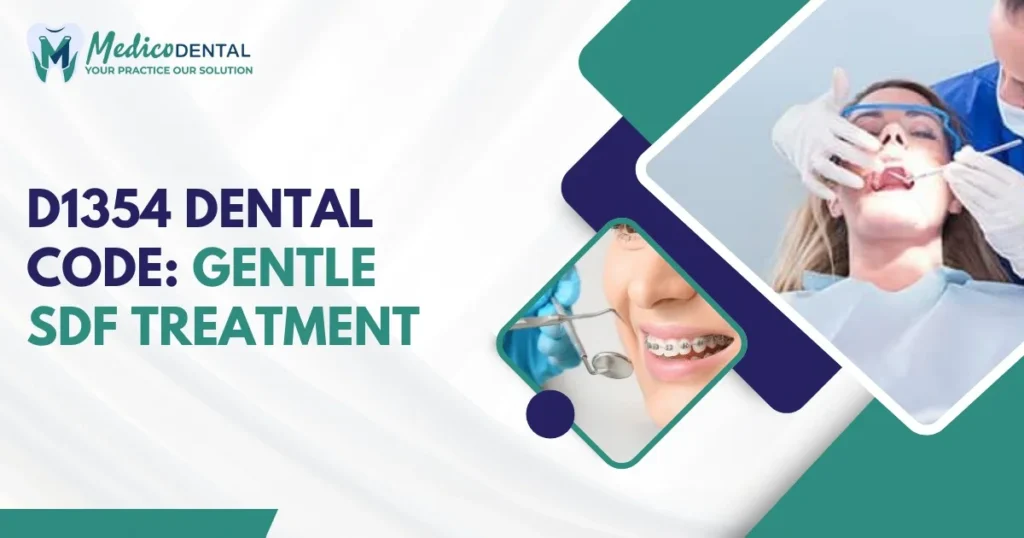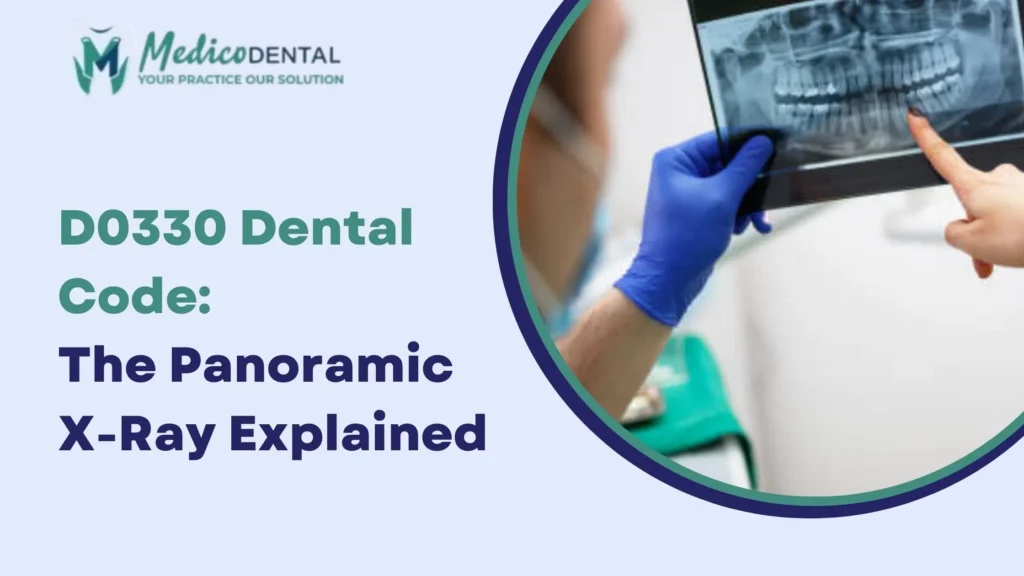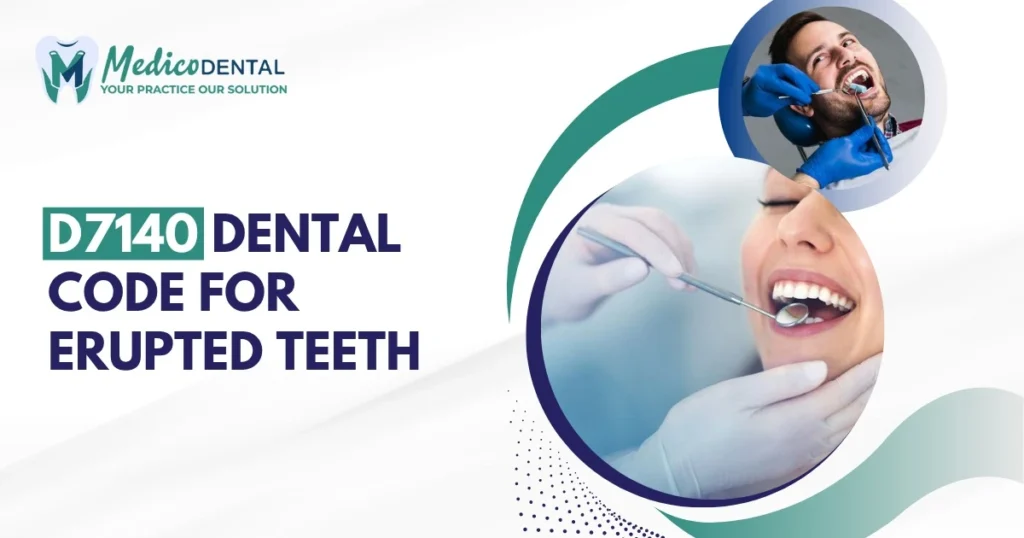The D1354 dental code, also known as “Application of Interim Caries Arresting Medicament (ICAM) per tooth,” represents a revolutionary approach to managing early-stage dental caries (commonly known as cavities). This code is used by dental professionals to describe a non-invasive procedure aimed at halting the progression of decay in the teeth without the need for drilling or anesthesia. The D1354 code is particularly associated with treatments like Silver Diamine Fluoride (SDF), a highly effective and affordable solution for arresting cavities, making it a valuable tool in preventive dentistry.
What is D1354 Dental Code?
Understanding the Application of Interim Caries Arresting Medicament (ICAM)
D1354 refers to the process of applying a caries arresting medicament to a tooth to stop the progression of decay. The primary substance used in this process is Silver Diamine Fluoride (SDF), a liquid compound that is applied directly to the surface of a cavity. It is primarily used for early-stage dental caries, specifically when the decay has not yet progressed to the point where a filling or more invasive treatment is necessary.
SDF works by creating a chemical reaction that penetrates the enamel and dentin, forming a barrier that prevents bacteria from further attacking the tooth. This medicament arrests the decay and stabilizes the affected area, often eliminating the need for traditional drilling and fillings.
Commonly Used Medicaments: Silver Diamine Fluoride (SDF)
SDF is the most commonly used caries arresting medicament for D1354. It contains both silver, which has antimicrobial properties, and fluoride, which strengthens tooth enamel and helps remineralize areas that are starting to decay. Silver Diamine Fluoride has been proven to be an effective treatment for both children and adults who have early-stage cavities, especially in cases where other options might be impractical or too costly.
The Procedure for Applying D1354
Step by Step Process of Applying ICAM
Applying D1354 with SDF is a simple and quick procedure that does not require local anesthesia or drills, making it especially suitable for patients who may be anxious about traditional dental treatments. Here’s how it typically works:
- Preparation of the Tooth: The dentist first cleans and dries the affected tooth area. This ensures that the SDF can be applied to the tooth surface without any obstructions.
- Application of SDF: A small amount of Silver Diamine Fluoride is then applied directly to the decayed area. The dentist uses a microbrush or applicator to spread the liquid evenly over the cavity.
- Setting Time: After the application, the dentist may ask the patient to avoid eating or drinking for 30 minutes to allow the medicament to set and bond with the tooth enamel.
- Post-Procedure Care: The treated area will likely look black or darkened temporarily, due to the reaction between the silver in SDF and the decayed tissue. However, this discoloration is not permanent and can be cleaned off with whitening treatments if desired.
How Dentists Use D1354 to Arrest Cavities
Dentists use D1354 to arrest cavities in early stages where the decay has not reached the pulp (the soft tissue inside the tooth) and is confined to the enamel or dentin. SDF is effective in halting the decay process, allowing patients to avoid more invasive treatments such as fillings or root canals. In some cases, this treatment is used as a temporary solution until more extensive care can be provided.
Benefits of D1354 Dental Code Treatment
Non-Invasive Nature and Benefits of Using SDF
One of the biggest advantages of D1354 and the use of Silver Diamine Fluoride is that the treatment is non-invasive. Unlike traditional fillings that require drilling and anesthetic injections, SDF is applied directly to the affected area, without the need for any invasive measures. This makes the treatment much less stressful for both children and adults, especially those with dental anxiety.
Effectiveness for Children and Adults with Early-Stage Cavities
SDF is particularly beneficial for children and older adults, as these groups may experience difficulty with traditional dental procedures. For children, SDF offers a gentler alternative to fillings, and it’s often used in cases where a child may have several cavities in a short period of time. For adults, especially those with limited mobility or health concerns, SDF is a safe and effective way to address early caries without the need for a series of invasive treatments.
Cost-Effectiveness and Convenience
Another benefit of D1354 is its cost-effectiveness. Since SDF treatment is quick and does not require extensive equipment or procedures, it is often more affordable than other treatment options like fillings or crowns. It’s also highly convenient for patients who need a fast solution, as the procedure can be completed in a single dental visit with little downtime required.
Coverage and Insurance for D1354
Insurance Policies and State Regulations Regarding D1354
The coverage for D1354 can vary depending on the patient’s insurance provider and the specific state regulations. Some insurance plans may cover the application of Silver Diamine Fluoride under preventive care or as a treatment for early-stage cavities. However, coverage may be limited based on the patient’s specific plan or the state’s Medicaid policies.
It’s essential to check with your dental insurance provider or dentist to understand whether your insurance will cover the cost of the procedure. Some states have Medicaid programs that cover SDF treatment for children, while others may include it as part of regular preventive dental care for adults through dental billing.
When is D1354 Covered Under Preventive Care?
In some cases, D1354 may be considered part of preventive care, especially for individuals who are at high risk of developing cavities. This could include children with early-stage cavities, elderly patients with limited access to traditional dental procedures, or those with special needs. Preventive care coverage often includes treatments that aim to prevent further dental issues or address small issues before they become more severe.
It is always recommended that you speak with your dentist to confirm the specifics of your insurance policy and the coverage for D1354 treatment.
Potential Side Effects and Considerations
Discoloration of Teeth Due to SDF
One of the most well-known side effects of the D1354 treatment (Silver Diamine Fluoride, or SDF) is the potential for discoloration of teeth. While SDF is effective in arresting dental caries (tooth decay), the silver component can cause a temporary darkening of the treated tooth’s surface. This discoloration can appear as a black or gray stain on the areas where the fluoride is applied, particularly in areas of active decay.
For many patients, especially those with visible cavities, this side effect can be a concern. However, it’s important to note that the discoloration typically occurs only in the decayed areas. Healthy tooth structure surrounding the treated site generally remains unaffected. The stain itself is not harmful and does not affect the strength or function of the tooth but may be aesthetically unpleasing to some patients.
Temporary Nature of the Staining and Whitening Options
The discoloration caused by SDF is not permanent. In most cases, the staining will fade over time as the tooth’s enamel naturally remineralizes. However, the length of time for this fading can vary depending on the severity of the decay and individual patient factors.
There are whitening options available for patients who wish to address the staining more quickly. Professional dental whitening treatments or at-home products may help reduce the appearance of the darkened areas. It’s crucial to discuss these options with your dentist to ensure that the whitening treatments used are safe for teeth that have undergone SDF application.
Who Can Benefit from D1354 Treatment?
Ideal Candidates for D1354 Application
D1354 treatment is primarily recommended for individuals dealing with early stages of tooth decay. This method is an excellent choice for both children and adults who have cavities that are not yet large enough to require invasive procedures like fillings. The ideal candidates for SDF treatment are those who:
- Have multiple cavities: SDF can arrest decay on several teeth in one treatment session, making it an efficient option for patients with widespread dental issues.
- Are at high risk for cavities: Individuals who have difficulty maintaining oral hygiene due to age, medical conditions, or disabilities may benefit from SDF’s preventive and arresting properties.
- Prefer a non-invasive solution: Patients who are apprehensive about traditional dental treatments (e.g., fillings or crowns) may find SDF to be a more comfortable and less intimidating alternative.
Special Considerations for Pediatric and Adult Patients
- Pediatric patients: SDF treatment is especially beneficial for children who may have difficulty cooperating with more conventional treatments. It’s often used in pediatric dentistry to arrest decay in young children without the need for anesthesia or invasive procedures. However, parents should be aware of the potential for staining, particularly if the child has visible decay.
- Adult patients: Adults with root caries or individuals who are at high risk of developing cavities due to dry mouth (often caused by medications or medical conditions) may also benefit from SDF treatment. However, adults should carefully consider the cosmetic impact of potential staining, especially if the treated areas are in the front of the mouth.
Alternatives to D1354 Treatment
Other Caries Arresting Methods and Their Comparison to D1354
While SDF is a highly effective and non-invasive option for managing cavities, there are other treatment methods available. Here’s a comparison of some common alternatives:
- Traditional Fillings: Dental fillings are often used for cavities that are more advanced than those treatable with SDF. While fillings can restore the structure and function of a decayed tooth, they require removal of the decayed tissue and can be more invasive. Fillings also come with their own set of considerations, such as the need for local anesthesia and the possibility of wearing down over time.
- Sealants: Dental sealants are used to prevent decay rather than arrest it. These thin coatings are applied to the chewing surfaces of the back teeth to protect against cavities. While they can be highly effective for prevention, they don’t address existing decay like SDF does.
- Fluoride Varnishes: Like SDF, fluoride varnishes can be used to strengthen enamel and arrest early-stage tooth decay. However, fluoride varnishes generally don’t have the same arresting power as SDF in terms of halting ongoing decay. The application process is similar, but fluoride varnish tends to wear off faster than SDF, requiring more frequent applications.
- Laser Therapy: Some dentists may use lasers to treat early cavities. Laser therapy can remove decayed tissue and may not result in the staining seen with SDF. However, laser therapy can be more expensive and may not be suitable for all types of cavities.
Each of these alternatives has its advantages and drawbacks, depending on the severity of decay, patient preferences, and cost considerations. Consulting with your dentist will help you determine which treatment is best for your unique situation.
Conclusion
In conclusion, D1354 (Silver Diamine Fluoride) offers a promising, non-invasive option for arresting dental decay, particularly for those who are not yet ready for more invasive procedures like fillings. The treatment is quick, cost-effective, and suitable for both pediatric and adult patients. It is especially useful for patients with multiple cavities or those at high risk of further decay. However, potential staining is a consideration that patients should be aware of, and while temporary, it may impact the aesthetic appearance of treated teeth.
Before deciding on whether D1354 treatment is right for you, it is essential to consult with a dentist. Your dental professional can assess your specific needs, consider any medical or aesthetic concerns, and guide you in making the most informed decision. Together, you and your dentist can develop a treatment plan that will provide the best outcomes for your oral health, ensuring that you achieve both effective decay management and a smile you feel confident about.
FAQs
What is D1354 (Silver Diamine Fluoride)?
Ans. D1354, commonly known as Silver Diamine Fluoride (SDF), is a liquid solution used to arrest dental cavities and prevent further tooth decay. It is applied topically to decayed areas of the teeth, where it works by hardening the tooth’s enamel and preventing the decay from spreading.
Is D1354 safe for children?
Ans. Yes, D1354 is considered safe for children, particularly those who have difficulty cooperating with traditional dental treatments. It is non-invasive and does not require anesthesia, making it a suitable option for young patients with early-stage cavities. However, parents should be aware of the potential for temporary staining on the teeth.
Does D1354 cause permanent staining?
Ans. No, the staining caused by Silver Diamine Fluoride is temporary. The discoloration occurs in areas of active decay, usually turning the tooth black or gray. The stain gradually fades over time as the tooth enamel remineralizes. For patients who want to reduce the stain more quickly, professional whitening treatments can be discussed with a dentist.
How long does the effect of D1354 last?
Ans. The effect of D1354 can last several months to a year or longer, depending on the severity of the cavity and the patient’s oral hygiene habits. The treatment arrests decay but does not reverse damage that has already been done. Therefore, it is important to follow up with a dentist for ongoing care and preventive measures.



